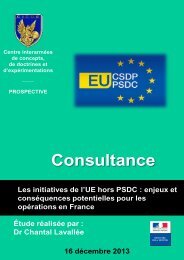Conference
science-research-bulletin-2013-conference
science-research-bulletin-2013-conference
You also want an ePaper? Increase the reach of your titles
YUMPU automatically turns print PDFs into web optimized ePapers that Google loves.
EUROPEAN POLICE SCIENCE AND RESEARCH BULLETIN<br />
SPECIAL CONFERENCE EDITION<br />
social media provide to existing systems of<br />
authorisation and regulation, particularly when<br />
applied to the collection of analysis of material<br />
produced by individuals on social media sites<br />
but which are openly accessible. There has been<br />
similar discussion in recent work by Eijkman<br />
and Weggemans (2013) and extensive further<br />
discussion now seems inevitable following the<br />
disclosures about the activities of the NSA.<br />
There has been less exploration of the<br />
effectiveness of social media usage. This is of<br />
course not to suggest that police engagement<br />
with social media has no effect. Police<br />
communications leads and investigators alike<br />
would have little time for it if this were the case.<br />
But there have been relatively few attempts<br />
systematically to look at what is different about<br />
the way the police interface with the police works<br />
when it takes place in social media environments,<br />
and how that interacts with, and changes, nonvirtual<br />
environments — in so far as this is a useful<br />
distinction to make. (Bartlett 2013).<br />
Assumptions that are made about the impact<br />
of social media use need to be well founded in<br />
evidence. Even if impact seems to be intuitively<br />
likely, and supported by anecdote, there is still<br />
a need for scrutiny. For example, in discussing<br />
social media as a means of pushing information,<br />
COMPOSITE (Denef et al. 2012) speculates that<br />
‘[w]hile not every citizen is using social media at<br />
all or is a member of the popular networks, social<br />
media encourages sharing information across<br />
people and networks, so that even citizens who<br />
are not directly subscribed to a police force’s<br />
information can also receive the updates through<br />
their friends. By using social media in this way,<br />
police forces become more independent from<br />
the press and open to immediate connection to<br />
the general public’ (p.18).<br />
This touches on a number of issues which<br />
invite further investigation and call for data.<br />
One is about the relationship between the<br />
mainstream press and social media. Social media<br />
are unquestionably of increasing important as<br />
a source for mainstream journalists. This was<br />
notably evidenced in the Arab Spring. There<br />
now appears to be some consensus that the<br />
crucial element is the interaction between social<br />
media and conventional media — and real world<br />
protest in this case.<br />
It is not necessarily the case that social media<br />
have had the disintermediating effect implied<br />
by COMPOSITE. Manuel Castells (2012), for<br />
example, considers that in Tunisia, ‘there was a<br />
symbiotic relationship between mobile phone<br />
citizen journalists uploading information to<br />
YouTube and Al Jazeera using feeds from citizen<br />
journalists and then broadcasting them to<br />
citizens at large’. Nor should we assume that<br />
the way these relationships work in a particular<br />
situation, as in extreme events such as riots or<br />
popular demonstration against the government<br />
, is a good guide to how people get information<br />
from social media or the press in, for example,<br />
less tense neighbourhood policing contexts.<br />
There are also signs of uneven development<br />
in the way social media are having impact on<br />
the press’s conceptualisation of its role, and<br />
of others’ appreciation of it. The discussion of<br />
police and press relationships which occupied<br />
public attention in the UK in 2012 during the<br />
Leveson Inquiry into the culture, practice and<br />
ethics of the press (Leveson 2012) is a case in<br />
point ( ). The very cautious acknowledgement<br />
that things were changing as a result of social<br />
media suggests at least that there is scope for<br />
more research.<br />
3. FURTHER DIRECTIONS<br />
There has been extensive academic research in<br />
non-police contexts about online behaviours<br />
and identity, the relationship between online<br />
networks and other social networks and users’<br />
attitudes to privacy, but this academic discourse<br />
has largely left policing to one side. This suggests<br />
three areas where the work of researchers can<br />
be further developed and applied to policing<br />
practice. The first theme is about quantitative<br />
research and the boundary between quantitative<br />
and qualitative work. The other two are about<br />
the scope for more qualitative work.<br />
3.1 BIG DATA<br />
Social media are a source of unprecedented<br />
amounts of data, a lot of it personal data in that<br />
it’s about individuals, and much of it apparently<br />
openly available and public at the same time.<br />
This looks like a boon for social scientists and<br />
investigative organisations like the police in<br />
equal measure. Both are attracted by the sudden<br />
108





